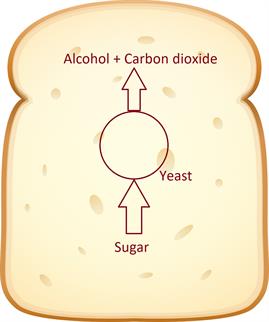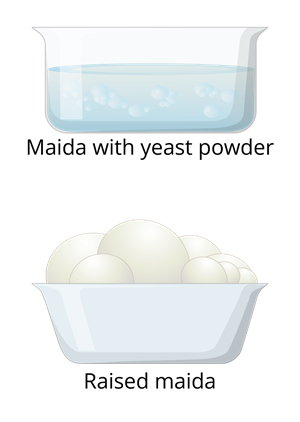
PUMPA - SMART LEARNING
எங்கள் ஆசிரியர்களுடன் 1-ஆன்-1 ஆலோசனை நேரத்தைப் பெறுங்கள். டாப்பர் ஆவதற்கு நாங்கள் பயிற்சி அளிப்போம்
Book Free DemoMicroorganisms - A friend:
Microorganisms are incredibly significant in our lives. Microorganisms are responsible for a large number of diseases, as we all know. However, you would be delighted to learn that they are more beneficial and friendly to humans than dangerous.
Some microorganisms, such as those used in bread, curd, and cakes, benefit everyday life. They have a wide range of applications, including food, agriculture, and pharmaceuticals. It also helps to clean the environment.
Microbes in household products:
Some of the household products enabled by microbial activity include:
Curd:
Have you ever seen your mother put a spoonful of curd into a glass of milk? And did you notice it was curdling after a while? With the aid of a microorganism, milk becomes curd.
Lactobacillus is a type of bacteria that aids in the production of curd. When a small amount of curd is mixed with milk, Lactobacillus bacteria convert the lactose sugar in the milk to lactic acid. Increased acidity in milk causes casein, a protein, to coagulate or form lumps, resulting in curd formation.
\text{Milk} \xrightarrow{\small{\text{at 30°C to 40°C/(Lactobacillus acid bacteria)}}} \text{Curd}
Making bread, idlis and dhoklas:
Yeast is a fungus that we use to add softness and fluffiness to bakery items like cake, pastries, and bread. It is also used to transforming maida batter (used for parottas) into a more soft and fluffy version.
Yeast is used to preparing a variety of foods, including bread, idlis, dosas, and dhoklas. When yeast is added to a dough, it begins to break down the sugar in the dough, releasing alcohol and carbon dioxide as a result. The dough rises and becomes fluffy due to the formation of carbon dioxide gas.

Figure depicting the action of yeast during bread formation
Even when making batter for idlis, bacteria play an essential role in giving the food softness and flavour. A batter that was just half the size of the vessel on the previous night occupies the whole space of the vessel the following day. What happened to cause that? The lactic acid bacterium Leuconostoc mesenteroides is responsible for the leavening action.
Important!
Note: Yeast produces carbon dioxide during anaerobic respiration, and it reproduces quickly. The respiration causes the gas bubbles which fill the dough, increasing its volume.
Activity: To show the effect of yeast on dough:
Procedure:
- Take 2 cups of maida or atta flour, a pinch of sugar, and a cup of warm water.
- Add a small amount of yeast powder and knead to make a soft dough.
- Cover the dough and set it aside for two hours.
Observation:
We will note that the dough has risen and increased in thickness. This occurrence is as a result of carbon dioxide produced by yeast during respiration.

Picture depicting the experiment showing the action of yeast in maida flour
Cheese:
The process of making cheese begins with the curdling of milk. The consistency and characteristics of cheese are determined by particular microorganisms, such as the Streptococcus lactis bacterium, which is used to make cottage cheese. Adding Lactobacillus bacteria to milk is also used in the manufacturing of cheese.
Commercial use of microorganisms:
We will learn how yeast contributes to the manufacture of alcohol by carrying out the following experiment.
Activity: To carry out fermentation of sugar:
Procedure:
- Take a 500 ml beaker and fill it 3/4 with water.
- Dissolve 2 to 3 teaspoons of sugar in it.
- Add half a teaspoonful of yeast powder to it.
- Cover it and keep it in a warm place for 4 to 5 hours.
- Now smell the solution.
Microorganisms are used to produce alcohols, wine, and acetic acid on a large scale. Fermentation is the mechanism of converting sugar into alcohol.
Fermentation is the breakdown of organic compounds by microorganisms to release energy in the absence of oxygen. For example, yeasts break down carbohydrates anaerobically to produce alcohol and carbon dioxide, and bacteria break down milk sugar to produce lactic acid.
In 1857, Louis Pasteur discovered fermentation. Yeast is also used in the industrial sector to make alcohol and wine. Sugar is made from grains such as maize, wheat, rice, and crushed fruit juices and other sources. Fermentation is caused by the action of yeast on sugar in a liquid medium.
Important!
- Acetic acid or vinegar is made by combining alcohol with bacteria called Acetobacter.
- Probiotics are live ingested microorganisms that have been linked to human and animal health benefits. As an example, curd's lactic acid bacteria boost the immune system and avoid intestinal problems.
- Lactobacillus bacteria increases vitamin B12 content. It is a nutrient that helps synthesise DNA (genetic material) and RBC (red blood cells). Vitamin B12 deficiency causes Anemia, severe damage to nervous system etc.